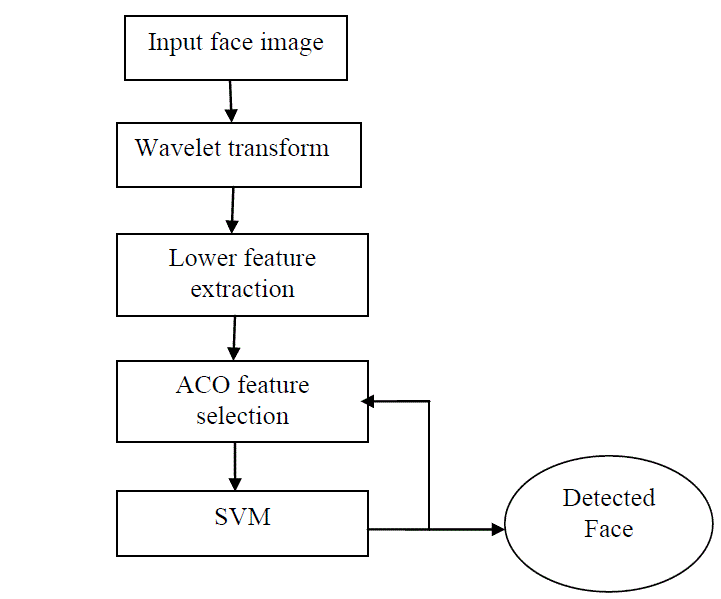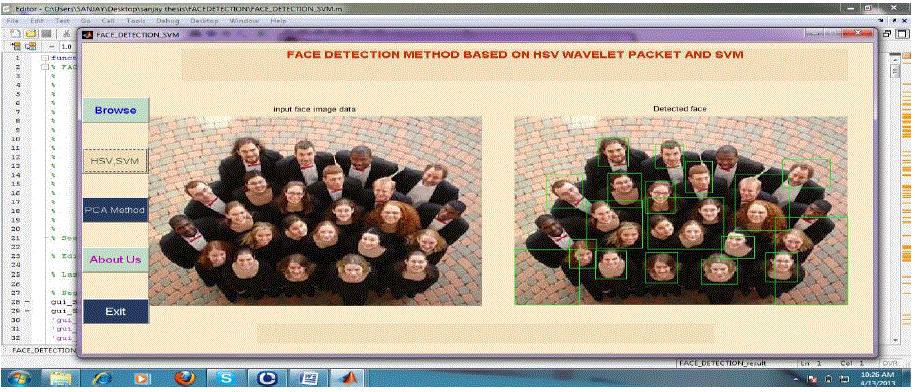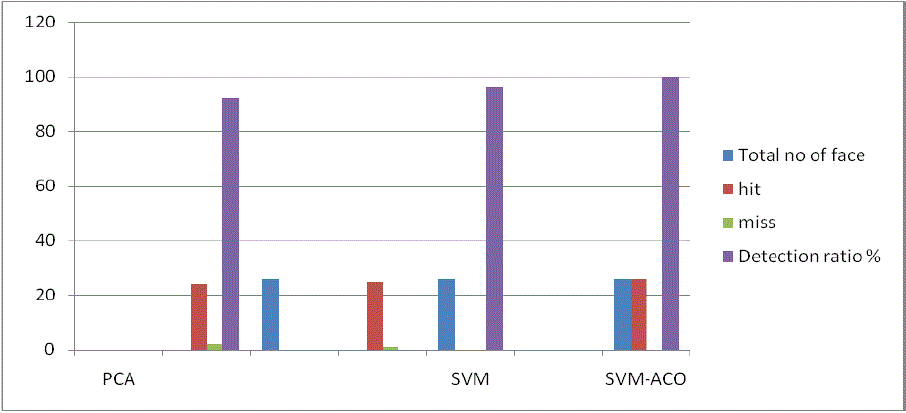Keywords
|
| Face detection, wavelet, ACO and SVM |
INTRODUCTION
|
| Feature selection process play important role in face detection system. The process of feature extraction in face detection implies as skin colour and morphological structure of human face. The processing of human face for feature extraction used wavelet transform. Human often uses faces to recognize persons and advancement in computing capability over the past few decades. The growth of face detection system is quite essential in a variety of application such as criminal surveillance and document verification etc. A number of face detection methods such as those using Eigen-faces [1] and neural network [2], have been developed. In these methods however a large amount of computation is required, making the processing extremely time consuming. Initial step of any processing of face is detecting the location in images where faces are present. But face diction from a single image is difficult because of variability in scale, locations, pose, and colour. There are many methods for the detection of face; colour is an important feature of human face. Using skin colour as feature for extracting a face increases the detection rate. Face recognition can be used for both verification and identification. Verification is done by comparing the two images. If the two images got matched means the input image is verified. Identification is done by comparing the input image with more than one image and finding the closest match of that input image. The method presented in this paper consists of three stepsskin reorganization, face reorganization and face recognition. The innovation of the proposed method is using skin reorganization filter as a pre-processing step for face reorganization. Feature descriptor can be defined as the process of mapping the image from image space to the feature space. Now a day, finding good features that effectively represent an image is still a difficult task. Feature descriptor is the core of the face detection [4]. As we all are acquainted with the fact that raw image data cannot be used directly in most computer vision tasks. Although two reasons behind this is the high dimensionality of the image makes it difficult to use the whole image. A large number of variations of features can be used for image face database. Face content can differentiate between visual and semantic content [13]. Features basically represent the visual content. Visual content can be further divided into general or domain specific. For understanding it comfortably we can take an example as the features that can use for searching would be representing the general visual content like colour, texture, and shape. On the other hand, the features that are used for searching human faces are domain-specific and may include domain knowledge. The process of feature extraction through wavelet transform has great advantage for lossless extraction of feature as layer of low frequency and high frequency. In process of hybrid detection technique is proposed and we have used support vector machine. The support vector machine is kernel based classifier, here kernel play a role of hyper plane. The size and efficiency of hyper plane decide the efficiency of detection. In detection process Support vector machine suffered two types of problem in region detection one is core point problem and another is outlier of feature point, in single class detection. But we used multi level class detection suffered a problem of unclassifiable regions problem. For the resolution of unclassified region problem used binary classifier such as one-against-one and one-against-all. In this section various methods discussed like support Vector Machine, Multi-class SVM, and finally discuss a proposed hybrid technique for SVM-ACO for multiclass detection process of face detection. The rest of paper is organized as follows. In Section II discuss wavelet and ACO. The Section III Proposed model. The section IV discusses experimental result and finally follows section V conclusion and future scope. |
WAVELET AND ACO
|
| In this section we discuss the wavelet transform and ant colony optimastion technique for face detection technique. Instead of shifts and modulates of a prototype function, one can choose shifts and scales, and obtain a constant relative bandwidth analysis known as the wavelet transform. To achieve this, take a real band pass filter with impulse response Ψ (t) and zero mean[8] |
 (1) (1) |
| Then, define the continuous wavelet transform as |
 |
| Here a?R+ and b?R. That is, we measure the similarity between the signal. f(t) and scales of an elementary |
function, since  (3) (3) |
| And the factor 1 / is used to conserve the norm. Now, the functions used in the expansion have changing time – frequency tiles because of the scaling. For small a (a < 1), Ψa,b(t) will be short and of high frequency, while for large a (a > 1), Ψa,b(t) will be long and of low frequency. Thus, a natural discretization will use large time steps for large a, and conversely, choose fine time steps for small a. [4] ACO makes probabilistic decision in terms of the artificial pheromone trails and the local heuristic information. This allows ACO to explore larger number of solutions than greedy heuristics [23,24]. Another characteristic of the ACO algorithm is the pheromone trail evaporation, which is a process that leads to decreasing the pheromone trail intensity over time. Pheromone evaporation helps in avoiding rapid convergence of the algorithm towards a sub-optimal region. ACO algorithm is used for feature subset selection in that ACO makes probabilistic decisions in terms of the artificial pheromone trails and the local heuristic information. Feature subset is generated using ACO by eliminating redundant and noisy features result in good predictive performance and reduced computation [11]. OAO and OAA classification based on SVM technique is efficient process, but this SVM based feature selection generate result on the unclassified of data. When the scale of data set increases the complexity of preprocessing is also increases, it is difficult to reduce noise and outlier of data set. Ant Colony Optimization (ACO) meta-heuristic is an effective tool in finding quality data [14] and that’s the main reason to use it as a feature selection for SVM. ACO-based feature selection procedure eliminates noise, outliers, and insignificant features from the feature. Next, the reduced feature is passed to SVM procedure. The proposed procedure improves an accuracy and efficiency of SVM procedure. It reduces the execution time of SVM algorithm without significantly altering the final classification configuration. It overcomes the drawback of the SVM algorithm for dealing with large features. |
PROPOSED MODEL FOR FACE DETECTION
|
| We proposed a new feature subset selection method for finding one-against-one classification for face detection without alteration of support vector machine. The proposed feature subset selection method is based on ant colony optimization; ant colony optimization is very famous meta-heuristic function for searching/finding similarity of data. In this method, we have introduced continuity of ants for similar features and dissimilar features collect into next node. In this process, ACO finds optimal selection of feature subset. Suppose ants find features of similarity in continuous root. Every ant of features compares their property value according to initial feature set. When deciding data is matched and unmatched, we should consider two factors: importance degree and easiness degree of matched and unmatched. While walking ants deposit pheromone on the ground according to importance of the unmatched and follow, in probability pheromone previously lay by other ants and the easiness degree of the matched. |
| Let D be the feature and m be the number of ants, importance degree a1, a2,…., an is c1, c2 ,c3 ……………..cn, the appetency of solutions searched by two ants is defined as |
 ......... (4) ......... (4) |
| where ci and cj is the importance of matched and unmatched path. The concentration of the solution (1) is defined as |
 .............(5) .............(5) |
| where δi and δj is the number of ants whose appetency with other ants is bigger than α; α can be defined as m/10, then the incremented pheromone deposited by ants is |
 .............(6) .............(6) |
| where Q is constant |
| Each level of pheromone modeled by means of a matrix τ where τij(t) contains the level of pheromone deposited in the node i and j at time t, ant k in node i will select the next node j to visit with probability, |
 |
| where ηij represents heuristic information about the problem which can be defined as the easiness of the path. The heuristic desirability of traversal and edge pheromone levels are combined to form the so-called probabilistic transition rule is given in equation (4), denoting the probability of an ant at feature i choosing to travel to feature j at time t. |
| Direct search in the best solution need global update rule applied as: |
 |
| where ρ(0<ρ≤1) is a parameter that control the pheromone evaporation. |
| The steps of the proposed ACO based data feature selection for SVM (ACO-SVM) are as follows: |
| Step 1: Initialization of ants and degree of importance for the acceptance of feature selection: The appetency of solutions searched by two ants is defined as |
 ...........(9) ...........(9) |
| where ci and cj is the importance of matched and unmatched path. |
| Step 2: Find the acceptance solution on given parameter of degree of acceptance: The concentration of the solution (1) is defined as |
 .................(10) .................(10) |
| where δi and δj is the number of ants whose appetency with other ants is bigger than α; α can be defined as m/10, where m is the number of ants. |
| Step 3: Check the acceptancy of the feature and update the value of pheromone with amount of Δτi: the incremented pheromone deposited by ants is |
 ..........(11) ..........(11) |
| Where Q is constant. |
| Step 4: Generate the feature selection matrix after the increment of pheromone value and selected features: Each level of pheromone modeled by means of a matrix τ where τij(t) contains the level of pheromone deposited in the node i and j at time t, ant k in node i will select the next node j to visit with probability, |
 (12) (12) |
| where ηij represents heuristic information about the problem which can be defined as the easiness of the path (ηij is the heuristic desirability of choosing feature j when at feature i), is the set of neighbor nodes of node i which have not yet been visited by the ant k. α > 0, β > 0 are two parameters that determine the relative importance of the pheromone value and heuristic information, and τij(t) is the amount of virtual pheromone on edge (i,j). |
| Step 5: Iterate and check feature matrix for processing of SVM mapping: Direct search in the best solution need global update rule applied as: |
 |
| where ρ(0<ρ≤1) is a parameter that control the pheromone evaporation. |
| Step 6: Finally, feature matrix is passed to SVM algorithm for obtaining final detection result of face. |
EXPERIMENTAL RESULT ANALYSIS
|
| To investigate the effectiveness of the proposed method for face detection based on feature selection model and support vector machine classifier with optimized feature selection set using ant colony optimization. We used matlab software 7.8.0 and some reputed image used for experimental task for group image of university student and some other student. The description of image is colour and dimension matrix is 512*512. |
CONCLUSION AND FUTURE SCOPE
|
| In this paper we proposed a robust method for face detection based on optimised feature selection process based on ant colony optimisation. The optimised feature selection process gives better result in compression of PCA and support vector machine based detection technique. In the process of feature extraction we used wavelet transform function, wavelet transform feature extraction process implied as details and approximation. The details part of transform function is preserved for direct use. And the approximate part used for processing for optimisation. The process of ant optimisation category into all feature in two section matched section and unmatched section. Our empirical result shows that better result in compression of PCA and support vector machine classifier. |
Tables at a glance
|
 |
| Table 1 |
|
Figures at a glance
|
 |
 |
 |
| Figure 1 |
Figure 2 |
Figure 3 |
|
References
|
- Liu, C. and Wechsler, H. (2002). “Gabor feature based classification using the enhanced fisher linear discriminant model for face recognition”Image processing, IEEE Transactions on 11:467-476.
- Romby, H.A, Baluja, S. and Kanade T. (1998). “Neural network based face detection”. Pattern Analysis and Machine Intelligence, IEEE Transactions on 20:23-38
- D. Hill, C. Studholme, and D. Hawkes, “Voxel similarity measuresfor automated image registration”, in Proceedings of Third SPIEConferenceon Visualization in Biomedical Computing,1994, pp. 205–216.
- F. Maesa, A. Collignon, D. Vandermeulen, G. Marchal, and P. Suetens, “Multimodality image registration by maximization of mutual information”,IEEE Transactions on Medical Imaging, vol. 6, no. 2, pp.187–198, 1997.
- H. K. Ekenel and R. Stiefelhagen, “Local appearance-based face recognition using discrete cosine transform,” presented at the 13th Eur. Signal Processing Conf., Antalya, Turkey, 2005.
- R. C. Gonzales and R. E. Woods, Digital Image Processing. Upper Saddle River, NJ: Prentice-Hall, 2001.
- Rui Min, AbdenourHadid and Jean-Luc Dugelay “Improving the Recognition of Faces Occluded by Facial Accessories” in IEEE ,2011.
- M. Sadeghzadeh and M.H. Shenasa, Correlation Based Feature Selection Using Genetic Algorithms, Proceedings of the Third International Conference on Modeling, Simulation and Applied Optimization, Sharjah, U.A.E. , 2009.
- M. Gletsos, S.G. Mougiakakou, G.K. Matsopoulos, K.S. Nikita, A. S. Nikita, and D. Kelekis. A Computer-Aided Diagnostic System to Characterized CT Focal Liver Lesions: Design and Optimization of a Neural Network Classifier, IEEE Transactions on Information Technology in Biomedicine, 7, 2003, 153-162.
- I.-S. Oh, J.-S. Lee, and B.-R. Moon, Hybrid Genetic Algorithms for Feature Selection, IEEE Transactions on Pattern Analysis and Machine Inteligence, 26, 2004, 1424-1437.
- M. Sadeghzadeh and M.H. Shenasa, Correlation Based Feature Selection Using Evolutionary Programming, Proceedings of the Twelfth IASTED International Conference on Artificial Intelligence and Soft Computing, Palma de Mallorca, Spain , 2008, 185-190.
- Sergey Kosov, Kristina Scherbaum, Kamil Faber, ThorstenThorma¨hlen, and Hans-Peter Seidel, “Rapid stereo-vision enhanced face detection”. in Proc. IEEE International Conference on Image Processing, pp.1221–1224.
- Sergey Kosov, Thorsten Thorma¨hlen, Hans-Peter Seidel, “Accurate Real-Time Disparity Estimation with Variational Methods”, in Proc.
- International Symposium on Visual Computing, pp.796–807.
- T.-H. Sun, M. Chen, S. Lo, and F.-C. Tien“Face recognition using 2D and disparity eigenface”, Expert Syst.Appl.,vol.33,no.2, pp.265–273.
- Rainer Lienhart, Alexander Kuranov, and VadimPisarevsky, 2003, “Empirical Analysis of Detection Cascades of Boosted Classifiers for Rapid Object Detection”, Springer-Verlag Berlin Heidelberg, LNCS 2781, pp. 297-304.
- Kevin W. Bowyer ,Kyong Chang, Patrick Flynn, “A survey of approaches and challenges in 3D and multi-modal 3D + 2D face recognition”, Computer Vision and Image Understanding (101), pp.1-15.
- F.Tsalakanidou, D.Tzovaras, “Use of depth and coloureigenfaces for face recognition”, Pattern Recognition Letters 24, 1427–1435.
- Yue Ming, QiuqiRuan, “Face Stereo Matching and Disparity Calculation in Binocular Vision System”, 2nd International Conference on Industrial and Information Systems, 281-284.
- Andrea F. Abate, Michele Nappi, Daniel Riccio, Gabriele Sabatino “2D and 3D face recognition: A survey”, Pattern Recognition Letters28,1885–1906.
- P. Viola and M. Jones, “Rapid object detection using a boosted cascade of simple features”, in Proc. IEEE Computer Vision and Pattern Recognition, pp. 511
- O. Nikisins and M. Greitans, “Reduced complexity automatic face recognition algorithm based on local binary patterns,”Peoceedings of 19thInternational Conference on Systems, Signals and Image Processing (IWSSIP 2012), pp. 447–450, 2012.
- Y. Wei and L. Tao, “Efficient histogram-based sliding window,” Proceedings of IEEE Conference on Computer Vision and Pattern Recognition (CVPR), 2010.
- J. Z. G. V. Struc and N. Pavesic, “Principal directions of synthetic exact filters for robust real-time eye localization,” Proceedings of COST 2101 European Workshop, BioID 2011, pp. 180–192, 2011.
|